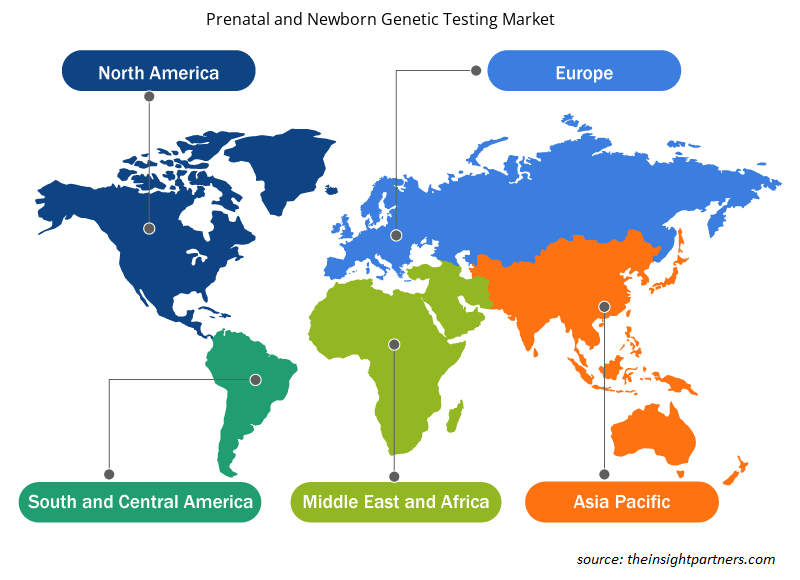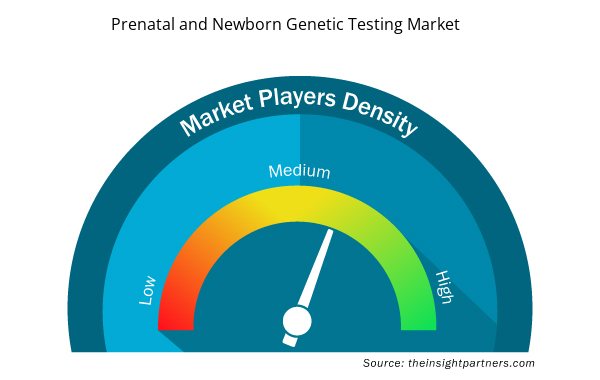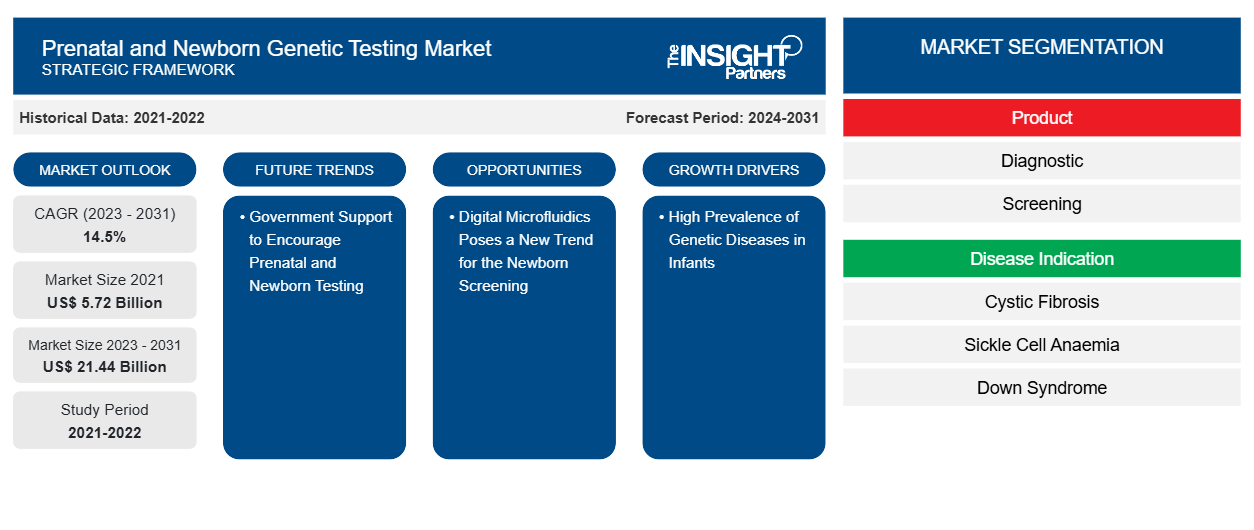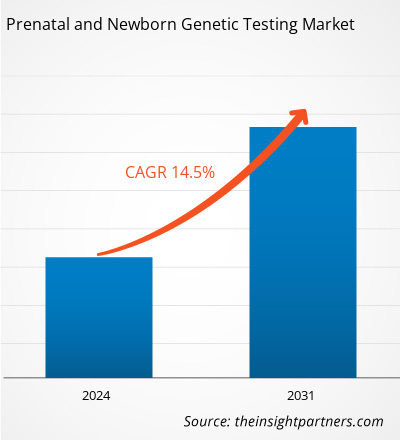出生前および新生児の遺伝子検査市場規模は2021年で57億2,000万米ドルに達し、2031年までに214億4,000万米ドルに達すると予測されています。市場は2023年から2031年にかけて14.5%のCAGRを記録すると予想されています。新生児スクリーニング用のデジタルマイクロフルイディクスは、出生前および新生児の遺伝子検査市場の主要トレンドであり続けると思われます。
出生前および新生児遺伝子検査市場分析
技術力の向上、出生前および新生児スクリーニングのための遺伝子検査の受容と認知度の高まり、個別医療への重点の高まりは、市場の成長を拡大している要因の一部です。市場の将来は、早期診断、十分な情報に基づく意思決定、妊婦と乳児の両方に対するより良い医療成果の向上において遺伝子検査ソリューションが果たす重要な役割によって形作られます。出生前および新生児スクリーニング分野で活動する診断会社の数の増加と、増加する公的および民間の投資により、予測期間中に市場の拡大が促進されると予想されます。
出生前および新生児遺伝子検査市場の概要
出生前遺伝子検査は、妊娠8~10週前に病気を診断したり、特定の遺伝子異常を検出したりするために妊娠中に行われます。ほとんどの出生前遺伝子検査では、さまざまなスクリーニングを実施するために母親の血液サンプルを使用します。遺伝子異常を特定するための出生前および新生児遺伝子検査の需要の高まり、およびGenomic Health Inc.や国立ヒトゲノム研究所などの公的機関や民間団体の存在が、市場の成長を支えています。米国臨床化学会(AACC)は、新生児スクリーニングを子供の健康を改善するための重要な要素として認識しています。乳児の遺伝性疾患の管理に向けた取り組みとして、AACCは新生児スクリーニングプログラムを維持、改善、拡大するための官民の取り組みを支持しています。さらに、妊娠合併症につながる母親の年齢の上昇により、出生前遺伝子検査の需要が世界的に高まっています。
要件に合わせてレポートをカスタマイズする
このレポートの一部、国レベルの分析、Excelデータパックなど、あらゆるレポートを無料でカスタマイズできます。また、スタートアップや大学向けのお得なオファーや割引もご利用いただけます。
- このレポートの主要な市場動向を入手してください。この無料サンプルには、市場動向から見積もりや予測に至るまでのデータ分析が含まれます。
出生前および新生児遺伝子検査市場の推進要因と機会
乳児の遺伝性疾患の有病率の高さが市場の成長を牽引
子宮内の胎児は、さまざまな遺伝性疾患の影響を受けます。これらの遺伝性疾患がどのように受け継がれるかは、妊娠に及ぼすリスクや再発リスクを判断するのに役立ちます。両親に遺伝性疾患を持つ別の子供がいる場合、遺伝性疾患の家族歴がある場合、または両親のいずれかに染色体異常がある場合など、新生児が遺伝性疾患を持つリスクはいくつかのケースで高くなります。乳児の間で遺伝性疾患がかなり蔓延しており、これらの疾患は世界中の乳児死亡率の原因でもあります。ダウン症候群は、世界で最も一般的な知的障害です。米国で診断される最も一般的な染色体異常であり、約700人に1人の乳児が罹患しています。米国疾病管理予防センター(CDC)のデータによると、米国では毎年約6,000人の乳児がダウン症候群で生まれています。世界保健機関は、これらの疾患により、世界中で毎年24万人の新生児が生後28日以内に死亡していると推定しています。さらに、生後 1 か月から 5 歳までの乳幼児 17 万人が先天性疾患により死亡しています。乳幼児の遺伝性疾患の蔓延により、出生前および新生児の遺伝子検査の需要が高まり、市場の成長を牽引しています。
出生前検査と新生児検査を奨励する政府の支援が市場の成長を後押し
ゲノム科学の分野が進歩するにつれ、遺伝子検査やゲノム検査はさまざまな臨床および医療機関でより一般的になりつつあります。世界中の政府や医療規制機関は、遺伝子検査の重要性とこれらの検査がもたらす利点を理解しつつあります。新生児の健康を確保するために、世界中の政府によって、赤ちゃんに新生児スクリーニングを受けることを義務付けるさまざまな取り組みが行われています。カリフォルニア新生児スクリーニング(NBS)プログラムは、すべての新生児をいくつかの深刻だが治療可能な遺伝性疾患についてスクリーニングする公衆衛生プログラムです。同様に、インドでは、バイオテクノロジー省が2019年にUMMIDイニシアチブ(遺伝性疾患の管理と治療の独自の方法)を立ち上げました。これは、国内で赤ちゃんの遺伝子スクリーニングを促進するように設計されています。したがって、世界中で出生前検査と新しい遺伝子検査の使用を促進するための政府からの支援の増加は、将来の市場の成長に貢献すると予想されます。
出生前および新生児遺伝子検査市場レポートのセグメンテーション分析
出生前および新生児の遺伝子検査市場分析の導出に貢献した主要なセグメントは、製品、疾患の適応、およびエンドユーザーです。
- 製品に基づいて、出生前および新生児の遺伝子検査市場は診断とスクリーニングに分かれています。スクリーニングセグメントは2023年に最大の市場シェアを占め、予測期間中に最高のCAGRを記録すると予想されています。
- 疾患の兆候別に見ると、市場は嚢胞性線維症、鎌状赤血球貧血、ダウン症候群、フェニルケトン尿症、およびその他の疾患に分類されます。ダウン症候群セグメントは2023年に市場で最大のシェアを占めました。さらに、嚢胞性線維症セグメントは予測期間中に最高のCAGRを記録すると予測されています。
- エンドユーザーに基づいて、出生前および新生児の遺伝子検査市場は、病院と診療所、診断センター、およびその他のエンドユーザーに分かれています。病院と診療所のセグメントは、2023年に最大の市場シェアを占めました。さらに、診断センターセグメントは、予測期間中に最高のCAGRを記録すると予想されています。
出生前および新生児遺伝子検査の地域別市場シェア分析
出生前および新生児遺伝子検査市場レポートの地理的範囲は、主に北米、アジア太平洋、ヨーロッパ、中東およびアフリカ、南米および中米の 5 つの地域に分かれています。
出生前および新生児の遺伝子検査市場は北米が独占しています。北米市場は、乳児の遺伝性疾患の罹患率の増加、政府の支援策、出生前および新生児検査の利用を促進するためのさまざまな組織による取り組み、出生率の上昇など、さまざまな要因により拡大しています。CDCによると、米国では毎年33人に1人の赤ちゃんが先天性欠損症に悩まされています。さらに、出生前および新生児検査の実施に関する規制義務、ヘルスケアにおける高度な方法の統合への注目の高まり、およびこの地域での出生前および遺伝子検査の診断のための非侵襲性検査の開始により、この地域の市場需要は予測期間中に大幅に増加すると予想されます。アジア太平洋地域は、今後数年間で最も高いCAGRで成長すると予想されます。
出生前および新生児遺伝子検査市場の地域別分析
予測期間を通じて出生前および新生児遺伝子検査市場に影響を与える地域的な傾向と要因は、Insight Partners のアナリストによって徹底的に説明されています。このセクションでは、北米、ヨーロッパ、アジア太平洋、中東およびアフリカ、南米および中米にわたる出生前および新生児遺伝子検査市場のセグメントと地理についても説明します。

- 出生前および新生児遺伝子検査市場の地域別データを入手
出生前および新生児遺伝子検査市場レポートの範囲
| レポート属性 | 詳細 |
|---|---|
| 2021年の市場規模 | 57億2千万米ドル |
| 2031年までの市場規模 | 214.4億米ドル |
| 世界のCAGR(2023年~2031年) | 14.5% |
| 履歴データ | 2021-2022 |
| 予測期間 | 2024-2031 |
| 対象セグメント | 製品別
|
| 対象地域と国 | 北米
|
| 市場リーダーと主要企業プロフィール |
|
出生前および新生児遺伝子検査市場のプレーヤー密度:ビジネスダイナミクスへの影響を理解する
出生前および新生児の遺伝子検査市場は、消費者の嗜好の変化、技術の進歩、製品の利点に対する認識の高まりなどの要因により、エンドユーザーの需要が高まり、急速に成長しています。需要が高まるにつれて、企業は提供を拡大し、消費者のニーズを満たすために革新し、新たなトレンドを活用し、市場の成長をさらに促進しています。
市場プレーヤー密度とは、特定の市場または業界内で活動している企業または会社の分布を指します。これは、特定の市場スペースに、その市場規模または総市場価値に対してどれだけの競合相手 (市場プレーヤー) が存在するかを示します。
出生前および新生児遺伝子検査市場で事業を展開している主要企業は次のとおりです。
- アボット
- クエストダイアグノスティクス株式会社
- バイオ・ラッド ラボラトリーズ株式会社
- イルミナ株式会社
- F.ホフマン・ラ・ロシュ株式会社
- キアゲン
免責事項:上記の企業は、特定の順序でランク付けされていません。

- 出生前および新生児遺伝子検査市場の主要な主要プレーヤーの概要を入手
出生前および新生児の遺伝子検査市場のニュースと最近の動向
出生前および新生児の遺伝子検査市場は、主要な企業出版物、協会データ、データベースを含む一次および二次調査後の定性的および定量的データを収集することによって評価されます。以下は、出生前および新生児の遺伝子検査および戦略の市場における動向のリストです。
- パーキンエルマー社は、新生児の脊髄性筋萎縮症(SMA)と重症複合免疫不全症(SCID)の同時検出を目的とした、認定研究室による体外診断(IVD)用EONIS SCID-SMAアッセイキットの販売について、米国食品医薬品局の認可を取得しました。これは、米国で初めてFDA認可を受けた新生児のSMAスクリーニング用アッセイであり、同社のより広範なEONISプラットフォームの一部です。(出典:パーキンエルマー社、プレスリリース、2022年)
- LifeCell International は、数千の幼児期発症疾患を評価する新生児向けのプレミア遺伝子診断テスト「Genome-Scope」を発売しました。(出典: LifeCell International Private Limited、プレスリリース、2020 年)
出生前および新生児遺伝子検査市場レポートの対象範囲と成果物
「出生前および新生児の遺伝子検査市場の規模と予測(2021〜2031年)」レポートでは、以下の分野をカバーする市場の詳細な分析を提供しています。
- 対象範囲に含まれるすべての主要市場セグメントについて、世界、地域、国レベルでの市場規模と予測。
- 市場の動向(推進要因、制約、主要な機会など)
- 今後の主な動向
- 詳細なPEST/ポーターの5つの力とSWOT分析
- 主要な市場動向、主要プレーヤー、規制、最近の市場動向を網羅した世界および地域の市場分析
- 市場集中、ヒートマップ分析、主要プレーヤー、最近の動向を網羅した業界の状況と競争分析
- 詳細な企業プロフィール
- 過去2年間の分析、基準年、CAGRによる予測(7年間)
- PEST分析とSWOT分析
- 市場規模価値/数量 - 世界、地域、国
- 業界と競争環境
- Excel データセット



Report Coverage
Revenue forecast, Company Analysis, Industry landscape, Growth factors, and Trends

Segment Covered
This text is related
to segments covered.

Regional Scope
North America, Europe, Asia Pacific, Middle East & Africa, South & Central America

Country Scope
This text is related
to country scope.
Trends and growth analysis reports related to Life Sciences : READ MORE..
The Insight Partners performs research in 4 major stages: Data Collection & Secondary Research, Primary Research, Data Analysis and Data Triangulation & Final Review.
- Data Collection and Secondary Research:
As a market research and consulting firm operating from a decade, we have published and advised several client across the globe. First step for any study will start with an assessment of currently available data and insights from existing reports. Further, historical and current market information is collected from Investor Presentations, Annual Reports, SEC Filings, etc., and other information related to company’s performance and market positioning are gathered from Paid Databases (Factiva, Hoovers, and Reuters) and various other publications available in public domain.
Several associations trade associates, technical forums, institutes, societies and organization are accessed to gain technical as well as market related insights through their publications such as research papers, blogs and press releases related to the studies are referred to get cues about the market. Further, white papers, journals, magazines, and other news articles published in last 3 years are scrutinized and analyzed to understand the current market trends.
- Primary Research:
The primarily interview analysis comprise of data obtained from industry participants interview and answers to survey questions gathered by in-house primary team.
For primary research, interviews are conducted with industry experts/CEOs/Marketing Managers/VPs/Subject Matter Experts from both demand and supply side to get a 360-degree view of the market. The primary team conducts several interviews based on the complexity of the markets to understand the various market trends and dynamics which makes research more credible and precise.
A typical research interview fulfils the following functions:
- Provides first-hand information on the market size, market trends, growth trends, competitive landscape, and outlook
- Validates and strengthens in-house secondary research findings
- Develops the analysis team’s expertise and market understanding
Primary research involves email interactions and telephone interviews for each market, category, segment, and sub-segment across geographies. The participants who typically take part in such a process include, but are not limited to:
- Industry participants: VPs, business development managers, market intelligence managers and national sales managers
- Outside experts: Valuation experts, research analysts and key opinion leaders specializing in the electronics and semiconductor industry.
Below is the breakup of our primary respondents by company, designation, and region:

Once we receive the confirmation from primary research sources or primary respondents, we finalize the base year market estimation and forecast the data as per the macroeconomic and microeconomic factors assessed during data collection.
- Data Analysis:
Once data is validated through both secondary as well as primary respondents, we finalize the market estimations by hypothesis formulation and factor analysis at regional and country level.
- Macro-Economic Factor Analysis:
We analyse macroeconomic indicators such the gross domestic product (GDP), increase in the demand for goods and services across industries, technological advancement, regional economic growth, governmental policies, the influence of COVID-19, PEST analysis, and other aspects. This analysis aids in setting benchmarks for various nations/regions and approximating market splits. Additionally, the general trend of the aforementioned components aid in determining the market's development possibilities.
- Country Level Data:
Various factors that are especially aligned to the country are taken into account to determine the market size for a certain area and country, including the presence of vendors, such as headquarters and offices, the country's GDP, demand patterns, and industry growth. To comprehend the market dynamics for the nation, a number of growth variables, inhibitors, application areas, and current market trends are researched. The aforementioned elements aid in determining the country's overall market's growth potential.
- Company Profile:
The “Table of Contents” is formulated by listing and analyzing more than 25 - 30 companies operating in the market ecosystem across geographies. However, we profile only 10 companies as a standard practice in our syndicate reports. These 10 companies comprise leading, emerging, and regional players. Nonetheless, our analysis is not restricted to the 10 listed companies, we also analyze other companies present in the market to develop a holistic view and understand the prevailing trends. The “Company Profiles” section in the report covers key facts, business description, products & services, financial information, SWOT analysis, and key developments. The financial information presented is extracted from the annual reports and official documents of the publicly listed companies. Upon collecting the information for the sections of respective companies, we verify them via various primary sources and then compile the data in respective company profiles. The company level information helps us in deriving the base number as well as in forecasting the market size.
- Developing Base Number:
Aggregation of sales statistics (2020-2022) and macro-economic factor, and other secondary and primary research insights are utilized to arrive at base number and related market shares for 2022. The data gaps are identified in this step and relevant market data is analyzed, collected from paid primary interviews or databases. On finalizing the base year market size, forecasts are developed on the basis of macro-economic, industry and market growth factors and company level analysis.
- Data Triangulation and Final Review:
The market findings and base year market size calculations are validated from supply as well as demand side. Demand side validations are based on macro-economic factor analysis and benchmarks for respective regions and countries. In case of supply side validations, revenues of major companies are estimated (in case not available) based on industry benchmark, approximate number of employees, product portfolio, and primary interviews revenues are gathered. Further revenue from target product/service segment is assessed to avoid overshooting of market statistics. In case of heavy deviations between supply and demand side values, all thes steps are repeated to achieve synchronization.
We follow an iterative model, wherein we share our research findings with Subject Matter Experts (SME’s) and Key Opinion Leaders (KOLs) until consensus view of the market is not formulated – this model negates any drastic deviation in the opinions of experts. Only validated and universally acceptable research findings are quoted in our reports.
We have important check points that we use to validate our research findings – which we call – data triangulation, where we validate the information, we generate from secondary sources with primary interviews and then we re-validate with our internal data bases and Subject matter experts. This comprehensive model enables us to deliver high quality, reliable data in shortest possible time.


 このレポートの無料サンプルを入手する
このレポートの無料サンプルを入手する